ADHD Cleaning Schedule: Practical Tips for a Tidy Home

Keeping your home tidy can be a real challenge when you have ADHD. You might find yourself struggling to stay on top of cleaning tasks, feeling overwhelmed by clutter, or forgetting to tackle important chores. But don't worry – creating an ADHD cleaning schedule can make a world of difference in managing your home and reducing stress.
In this article, we'll explore practical strategies to help you develop an ADHD-friendly cleaning routine. You'll learn how to break down tasks into manageable steps, set up a customized schedule that works for you, and discover ADHD organization techniques to keep your space tidy. We'll also share cleaning tips for ADHD individuals and discuss ways to stay motivated and consistent with your ADHD home management efforts. By the end, you'll have the tools to create an effective ADHD-friendly checklist and transform your living space.
Start mastering your ADHD cleaning challenges with Bonding Health! Sign up for our beta app and access free journals packed with expert tips and strategies. Elevate your home management skills today at Bonding Health. Join us now and transform your approach to ADHD.
Understanding ADHD and Cleaning Challenges
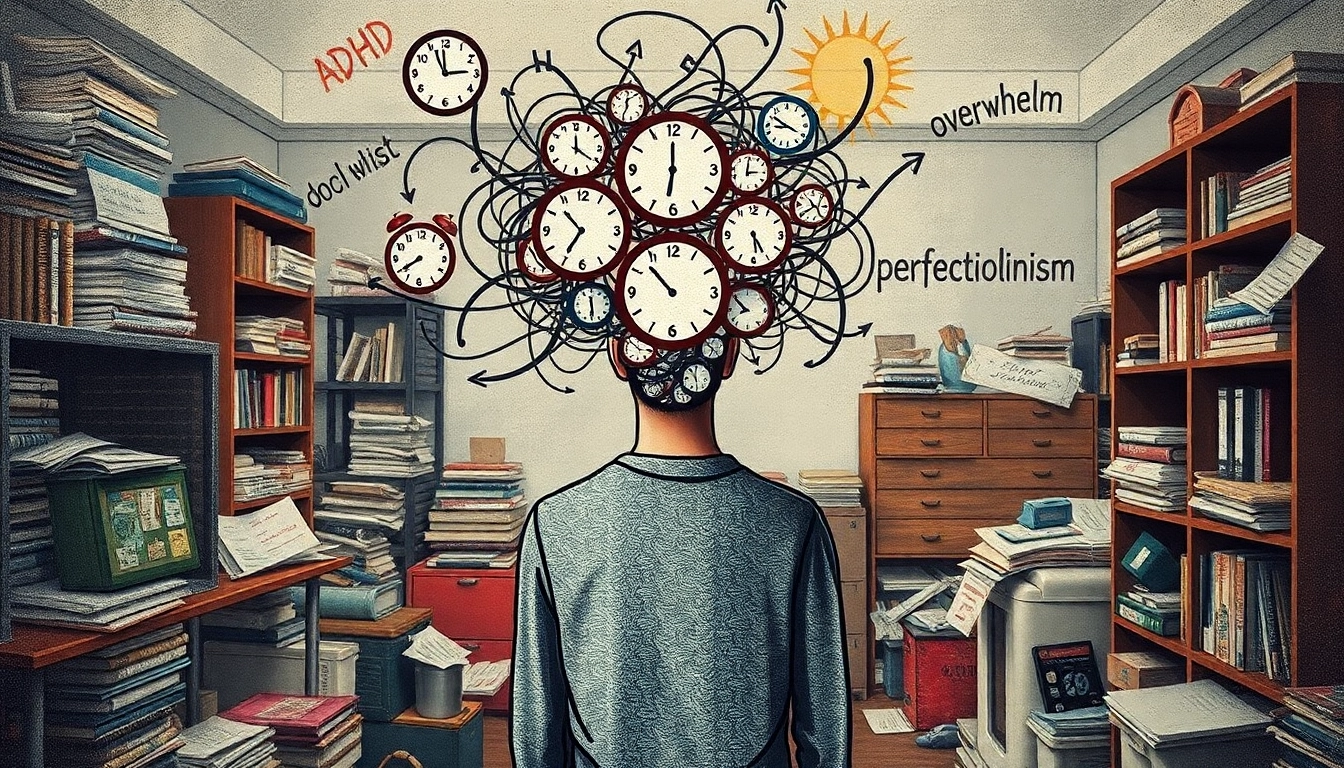
Living with ADHD can make keeping your home tidy a significant challenge. The unique characteristics of ADHD can impact your ability to maintain a clean living space. Let's explore some of the key factors that contribute to these challenges.
Executive Function Difficulties
ADHD affects the brain's executive functions, which are responsible for planning, organizing, focusing, impulse control. This can make it difficult for you to:
-
Plan and initiate cleaning tasks
-
Break down cleaning projects into manageable steps
-
Maintain focus on cleaning activities
-
Remember to complete regular household chores
Overwhelm and Procrastination
The combination of ADHD symptoms and cleaning tasks can often lead to feelings of overwhelm and procrastination. Here's why:
-
Task Complexity: ADHD brains tend to seek quick rewards and stimulation due to a dopamine deficit. Complex or time-consuming cleaning tasks may cause your brain to "go on strike."
-
Difficulty Getting Started: For adults with ADHD, just beginning a task can be challenging, especially if it's not intrinsically interesting. You might find yourself easily distracted by other stimuli or internal thoughts.
-
Time Management Issues: ADHD can impair your sense of time, making it hard to estimate how long cleaning tasks will take. This can lead to putting off tasks, thinking you still have enough time to complete them later.
-
Anxiety and Paralysis: The fear of not doing a task correctly or the anxiety associated with starting can create additional obstacles. This can result in a painful sense of paralysis when faced with cleaning projects.
Perfectionism
Contrary to common stereotypes, perfectionism can be associated with ADHD.
-
Setting impossibly high standards for cleanliness
-
Procrastinating because conditions aren't "just right" to start cleaning
-
Developing a negative self-image when unable to meet unrealistic cleaning goals
Perfectionism can become an unhealthy coping mechanism, where you try to meticulously control every detail as a way to override executive dysfunction. While this pressure to perform can provide temporary motivation, it often leads to burnout and further procrastination due to constant negative feedback and self-criticism.
Understanding these challenges is the first step to developing effective strategies for managing your ADHD cleaning schedule. In the following sections, we'll explore practical tips and techniques to help you create a cleaning routine that works with your ADHD, rather than against it.
Creating a Customized ADHD-Friendly Cleaning Schedule
Creating an ADHD-friendly cleaning schedule can help you maintain a tidy home without feeling overwhelmed. By breaking tasks into manageable chunks, using visual aids, and implementing time-boxing techniques, you can develop a routine that works for you.
Breaking Tasks into Manageable Chunks
One of the most effective strategies for ADHD cleaning is to break tasks into smaller, more manageable sections. This approach helps prevent feelings of overwhelm and makes it easier to start and complete cleaning tasks. Here's how you can do it:
-
Assign specific tasks to different weekdays. For example, clean the bathrooms on Monday, vacuum the floors on Tuesday, and so on.
-
Create a checklist of cleaning tasks. Include specific items like "vacuum the living room" or "dust the blinds." This visual reminder helps you keep track of what needs to be done and allows you to check things off as you complete them.
-
Focus on one small task at a time. Instead of trying to clean an entire room at once, concentrate on individual components. For instance, when cleaning the kitchen, break it down into wiping surfaces, organizing cabinets, and cleaning the refrigerator.
-
Start with small, achievable goals. For example, commit to washing one dish at a time or doing one load of laundry daily. This approach can help you build momentum and avoid cleaning burnout.
Using Visual Aids
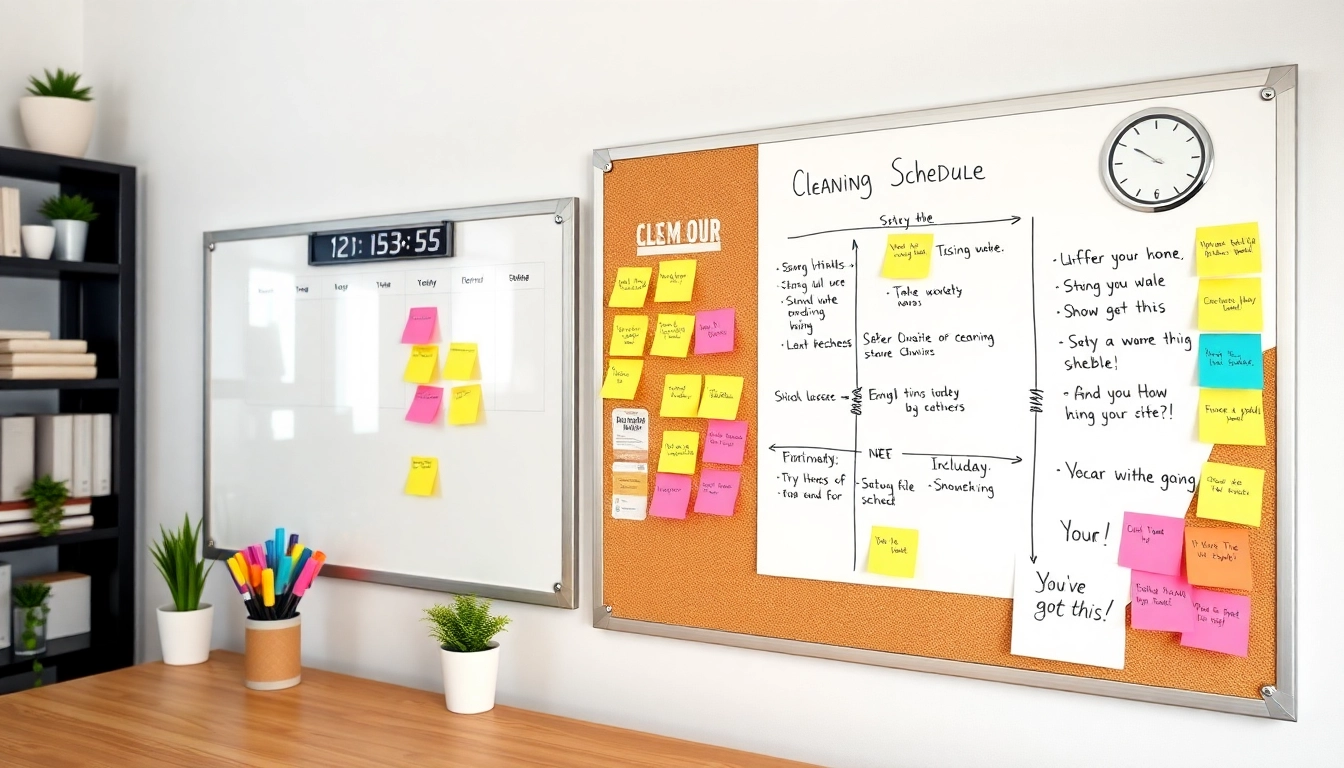
Visual aids can be powerful tools for ADHD individuals, helping to make cleaning tasks more engaging and manageable. Consider incorporating these visual strategies:
-
Use a visual timer: A timer can turn cleaning into a game-like experience. Set a specific time frame for each task and challenge yourself to complete it before the timer runs out.
-
Create a visual cleaning schedule: Use a physical calendar or whiteboard placed in a prominent location to display your cleaning tasks. This serves as a constant reminder of what needs to be done.
-
Implement color-coding: Assign different colors to various cleaning tasks or areas of your home. This can help you quickly identify and focus on specific cleaning activities.
Implementing Time-Boxing Techniques
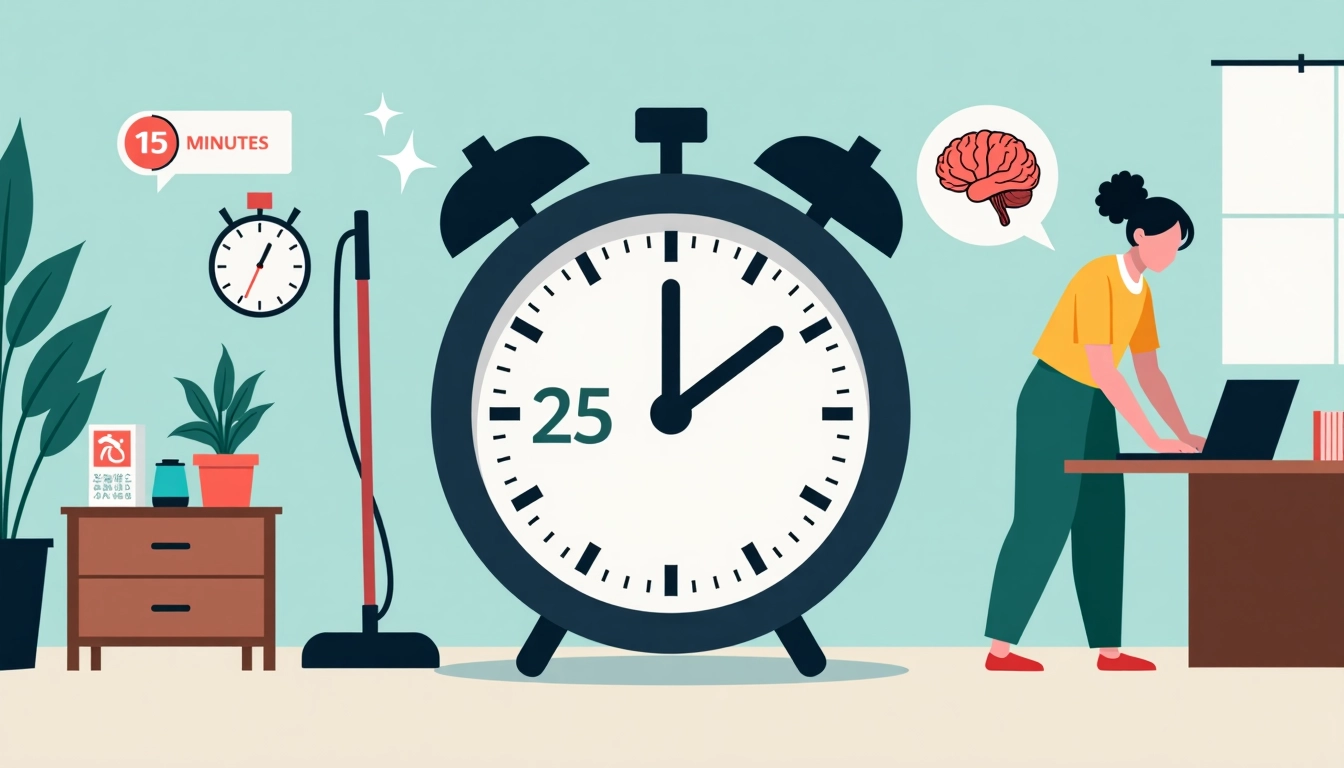
Time-boxing is an effective technique for managing cleaning tasks with ADHD. It involves allocating specific time frames for each activity, which helps maintain focus and prevents spending excessive time on a single task. Here's how to implement time-boxing:
-
Use the Pomodoro Technique: Work on cleaning tasks for a set period (e.g., 25 minutes) followed by a short break. Use a visual timer with an audible alert to mark the end of each work interval. With ADHD you may not need to adapt the pomodoro technique such as 15 minutes working and 10 minutes.
-
Set time limits for tasks: When creating your cleaning checklist, add time limits for each task. For example, "vacuum for 15 minutes" or "clean bathroom for 20 minutes."
-
Use magnetic timers: The Time Timer Twist, with its magnetic backing, can be attached to appliances like refrigerators or ovens. This makes it easy to keep track of cleaning time while moving around your home.
-
Be flexible: If you finish a task before the allocated time, move on to the next item on your list. If you don't complete everything within the set time, that's okay too. The goal is to make progress, not perfection.
By implementing these strategies, you can create a customized ADHD-friendly cleaning schedule that works for you. Remember, it's about finding a balance that keeps your home tidy without causing stress or overwhelm. Don't be afraid to adjust your approach as needed and celebrate the progress you make along the way.
Essential Cleaning Strategies for ADHD Individuals
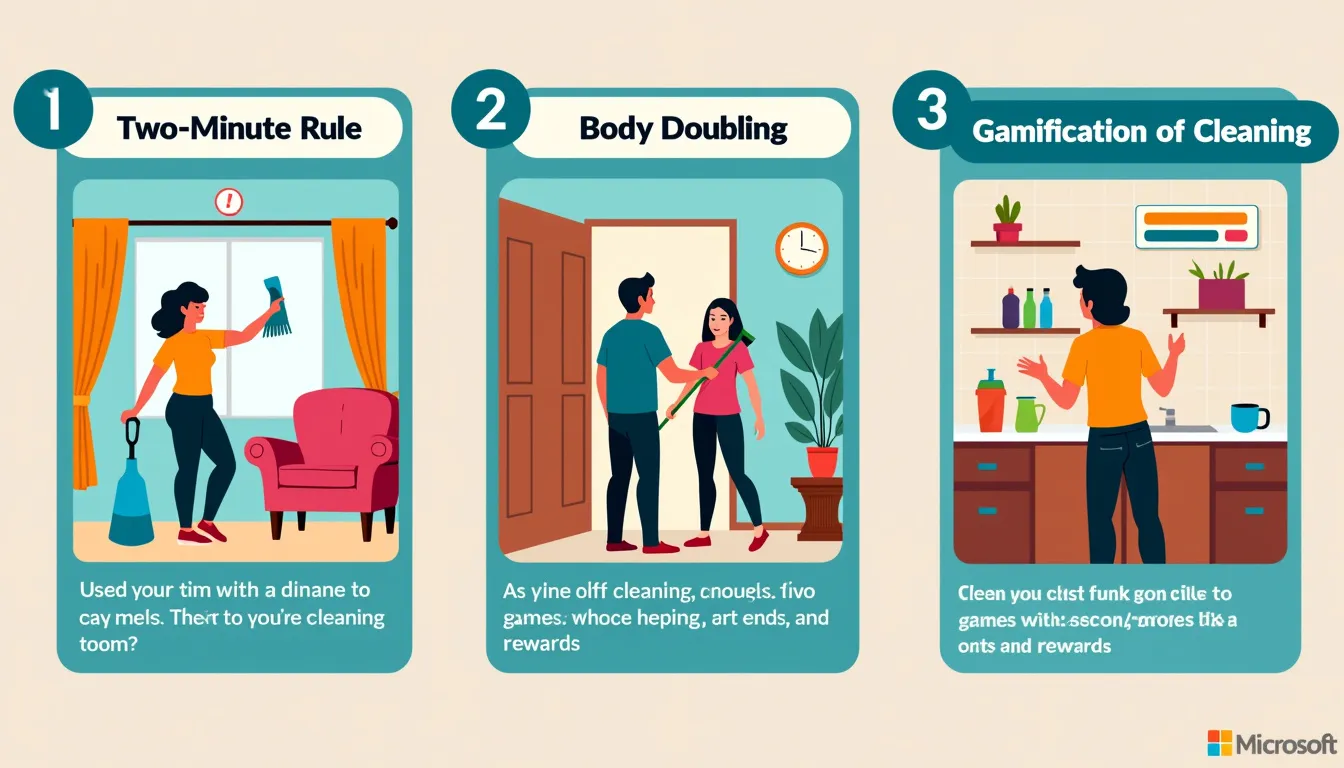
The Two-Minute Rule
The Two-Minute Rule, coined by productivity consultant David Allen, can be a game-changer for individuals with ADHD. This simple yet effective strategy suggests that if a task takes two minutes or less to complete, you should do it immediately. For those with ADHD, this approach can help overcome the challenge of task initiation and reduce the overwhelming feeling of a long to-do list.
To make the Two-Minute Rule work for you:
-
Start small: Begin with simple tasks like putting away a single item or wiping down a surface.
-
Be flexible: If two minutes feels too short, adjust the time to fit your needs. Make it a Five-Minute Rule if that works better for you.
Use it as a starter task: For larger cleaning projects, use the Two-Minute Rule to get the ball rolling. For example, challenge yourself to see how many dishes you can wash in two minutes.
Remember, the goal is to create momentum and build a habit of taking action. Even if you don't finish the task in two minutes, you've made progress and are more likely to continue.
Body Doubling
Body doubling is a strategy that has gained popularity, especially in ADHD communities. It involves working alongside another person, each doing your own tasks, but using each other's company as motivation to stay focused. This technique can be particularly helpful for cleaning and organizing tasks.
Here's how to use body doubling effectively:
-
Invite a non-judgmental friend: Ask someone to be present while you clean or organize. They don't need to help with the task itself; their presence is enough.
-
Use virtual body doubling: Set up a video call with someone who is also working on their own tasks. You can check in periodically to share progress and encourage each other.
-
Join online body doubling sessions: Many ADHD communities offer virtual body doubling sessions where you can work alongside others remotely.
Body doubling creates a sense of accountability and can help you stay on track with your cleaning tasks. It also provides a subtle reminder to stay focused, as you're aware that someone else is present.
Gaming of Cleaning Tasks
Turning cleaning into a game can make it more engaging and manageable for individuals with ADHD. Gamification taps into the competitive nature that many people with ADHD possess and can help maintain focus and motivation.
Try these gamification strategies:
-
Beat the clock: Time yourself as you complete chores and try to beat your previous record. Use a physical timer to help combat time blindness.
-
Point system: Assign points to different cleaning tasks based on difficulty or time required. Set a goal for how many points you want to earn each day or week.
-
Reward system: Create a list of rewards for yourself and "unlock" them as you complete cleaning tasks.
-
The "5 Things" method: Focus on just five categories in any room: trash, laundry, dishes, items with a place, and items without a place. This simplifies the cleaning process and makes it feel more achievable.
Remember, the key is to make cleaning feel less like a chore and more like an engaging activity. Don't be afraid to get creative with your gamification strategies – the more fun and personally appealing they are, the more likely you are to stick with them.
By implementing these strategies – the Two-Minute Rule, body doubling, and gamification – you can create an ADHD-friendly cleaning routine that works for you. Remember to be patient with yourself and celebrate your progress, no matter how small. With consistent effort and the right approach, maintaining a tidy home can become more manageable and less overwhelming.
Maintaining Motivation and Consistency
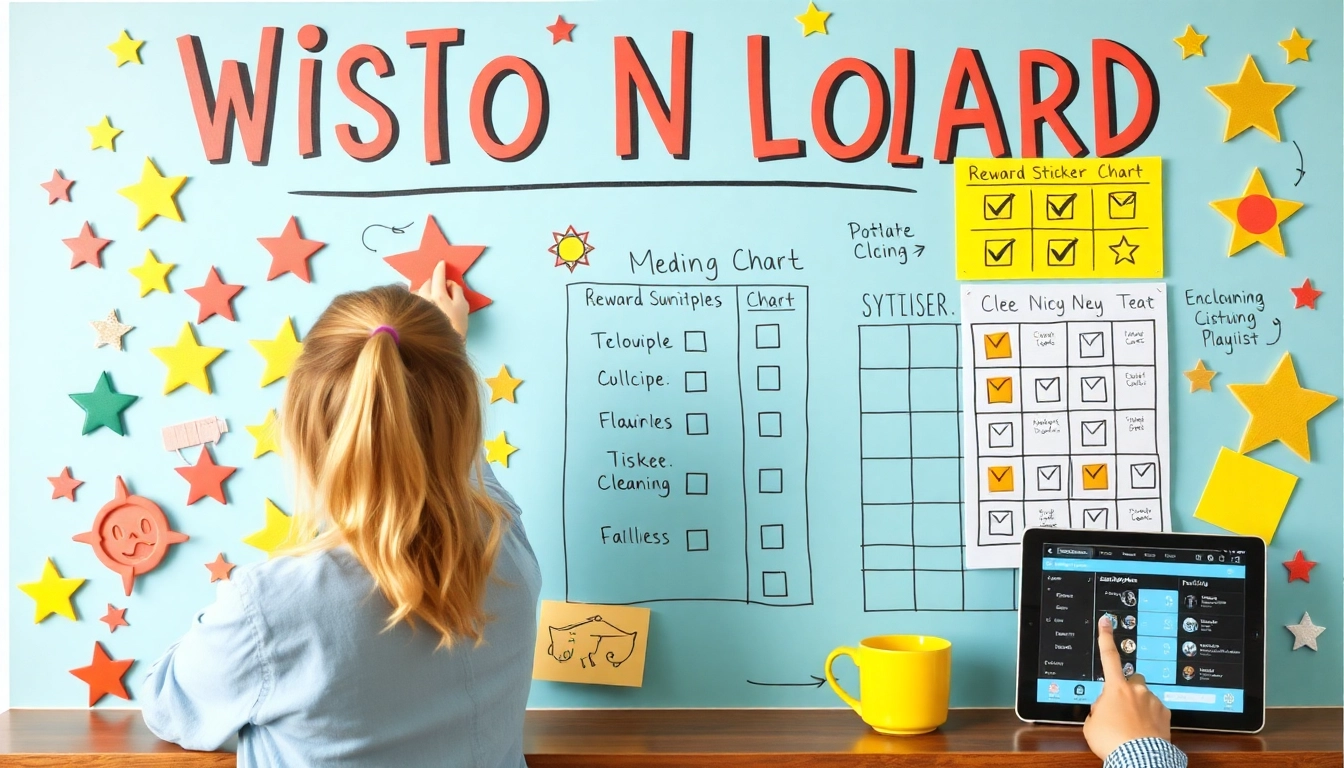
Maintaining motivation and consistency can be challenging for individuals with ADHD when it comes to cleaning and organizing. However, with the right strategies, you can make these tasks more manageable and even enjoyable. Here are some effective approaches to help you stay on track:
Reward Systems
Implementing a reward system can be a powerful motivator for completing cleaning tasks. By giving yourself something to look forward to, you're more likely to push through and finish the job. Here are some ideas to create an effective reward system:
-
Treat yourself: After completing a cleaning task, reward yourself with a cup of tea, your favorite TV show, or a well-deserved nap.
-
Use the "Queen of Play" approach: Incorporate ADHD motivators like competition, urgency, novelty, interest, humor, and play into your cleaning routine.
-
Create a playlist: Put together a selection of songs that get you motivated. Music can give your brain the jolt of dopamine it needs to stay engaged.
-
Turn cleaning into a game: Use apps like Habitica to transform mundane tasks into quests, earning rewards as you complete them.
Progress Tracking
Tracking your progress can help you visualize your accomplishments and maintain momentum. Here are some strategies to effectively track your cleaning progress:
-
Use visual timers: Timers can help you see time passing, creating a sense of urgency and helping you combat time blindness.
-
Set realistic goals: Calculate how much time it takes to manage and care for your household. Aim for 20-25 hours per week and use timers to help figure this out.
-
Break tasks into manageable chunks: Assign specific tasks to different weekdays, such as cleaning bathrooms on Monday and vacuuming floors on Tuesday.
-
Create a checklist: Make a list of specific cleaning tasks, like "vacuum the living room" or "dust the blinds." This visual reminder helps you keep track of what needs to be done.
-
Leverage technology: Consider investing in tools like a Roomba to make certain cleaning tasks easier and more manageable.
Self-Compassion
Practicing self-compassion is crucial for maintaining motivation and consistency, especially for individuals with ADHD. Here's how you can incorporate self-compassion into your cleaning routine:
-
Embrace imperfection: Remember that it's okay if everything isn't perfect. It's better to vacuum for 30 minutes and get as much done as possible than to hyperfocus on one small area.
-
Be kind to yourself: Treat yourself with care and understanding instead of harsh judgment. Ask yourself, "What can I do to help?" rather than "What's wrong with me?"
-
Normalize your experiences: Recognize that you're not alone in your struggles. Everyone faces challenges, and it's normal to have difficulties with organization and cleaning.
-
Practice self-compassion exercises: When you experience negative thoughts, try picturing yourself at age 10 and consider how you would comfort that younger version of yourself.
-
Acknowledge common humanity: Remember that all humans experience pain and suffering in some way. Your struggles with cleaning and organization are part of the shared human experience.
By implementing these strategies for maintaining motivation and consistency, you can create a more sustainable and enjoyable cleaning routine. Remember to be patient with yourself and celebrate your progress, no matter how small. With time and practice, maintaining a tidy home can become more manageable and less overwhelming.
Unlock Your ADHD Management Toolkit
Ready to transform your approach to ADHD cleaning and organization? Join the Bonding Health community today! Our beta app is designed specifically for parents managing ADHD, focusing on emotional regulation and practical strategies to enhance daily life. Sign up now to gain exclusive access to our free journals, where you'll find the latest research and tips on ADHD. Together, we can make your home management journey smoother and more effective. Start your journey to a tidier, stress-free home today by visiting Bonding Health.
Conclusion
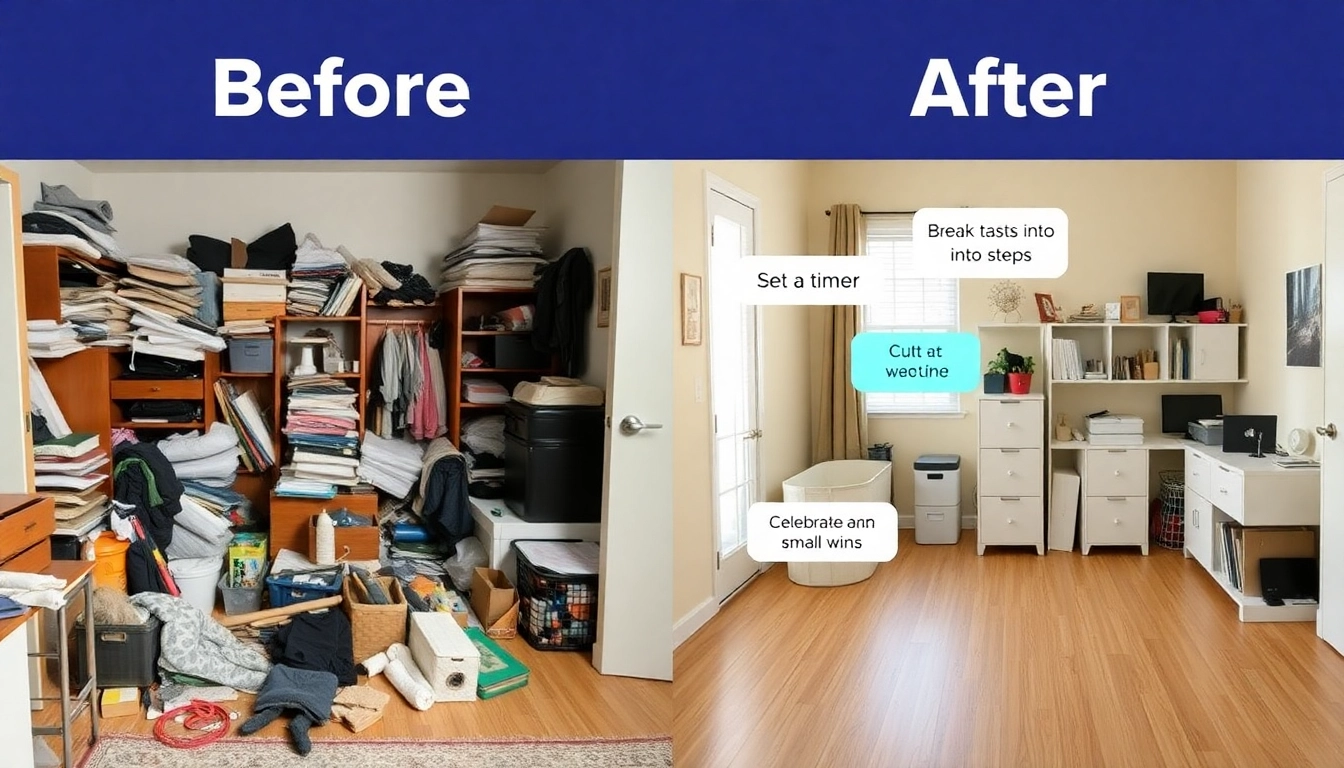
Creating an ADHD-friendly cleaning schedule can make a world of difference in managing your home and reducing stress. By breaking tasks into manageable chunks, using visual aids, and implementing time-boxing techniques, you can develop a routine that works for you. Remember to be patient with yourself and celebrate your progress, no matter how small. With consistent effort and the right approach, maintaining a tidy home can become more manageable and less overwhelming.
Incorporating strategies like the Two-Minute Rule, body doubling, and gamification can help make cleaning tasks more engaging and achievable. By practicing self-compassion and using reward systems, you can stay motivated and consistent in your cleaning efforts. Keep in mind that everyone faces challenges, and it's okay if everything isn't perfect. To wrap up, maintaining a clean home with ADHD is possible with the right tools and mindset.
FAQs
How can I develop an ADHD-friendly cleaning schedule?
To create a cleaning schedule that accommodates ADHD, start by identifying cleaning strategies that work best for you. Break tasks into smaller, manageable steps, invest in cleaning tools that simplify the process, and establish a specific area in your home as a "drop zone" for everyday items.
Is it possible for individuals with ADHD to maintain a tidy environment?
Yes, individuals with ADHD can maintain a tidy environment, although experiences vary widely. Some may struggle with messiness or disorganization, but with effective ADHD management and treatment strategies, many find it easier to organize their spaces.
What are some effective strategies to manage clutter if you have ADHD?
To manage clutter effectively, spend around 15 minutes each day tidying up, which could include throwing away unnecessary items or filing important documents. It’s also helpful to have at least one designated junk drawer in each room for items that don't yet have a permanent place.
What strategies can help motivate someone with ADHD to do housework?
To enhance motivation for housework when you have ADHD, consider breaking tasks into smaller goals, organizing your to-do list, seeking assistance when needed, keeping activities engaging, celebrating progress with rewards, trying body doubling, avoiding reliance on last-minute pressure, and varying your routine to keep things interesting.



